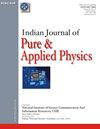~ 200和250质量区复合核裂变中子多重度的统计模型分析
IF 1.1
4区 物理与天体物理
Q4 PHYSICS, MULTIDISCIPLINARY
引用次数: 0
摘要
对现有文献中两个质量区的中子多重率(Mpre)数据,分别在~ 200和250两个不同质量区的复合核进行了统计模型分析,分别考虑了能级密度的壳层修正和能级密度的集体增强(CELD)效应。所选的反应具有相似的激发能范围。除了19F + 184W外,测量到的中子多重度随化合物核激发能的增加而增加。与两个质量区域重叠激发能范围的实验值相比,裂变前中子多重度的计算值被明显低估,并且在较重质量区域(ACN ~ 250)与相对较轻质量区域(ACN ~ 200)相比,被进一步低估。在两个质量区,复现实验值所需的耗散强度随复合核激发能的增加而增加。与不考虑这些影响的耗散强度相比,当考虑水平密度和CELD的壳修正影响时,耗散强度更高。本文章由计算机程序翻译,如有差异,请以英文原文为准。
Statistical Model Analysis of Neutron Multiplicities from Fission of Compound Nuclei in ~ 200 and 250 Mass Region
Statistical model analysis has been performed with and without the inclusion of shell correction in level density and the collective enhancement of level density (CELD) effect for two different mass regions of compound nuclei, i.e., ~ 200 and 250 for the currently available data of neutron multiplicity (Mpre) in the literature in both mass regions. The chosen reactions have comparable excitation energy range. The measured neutron multiplicities are found to be increasing with the excitation energy of the compound nuclei for all the studied reactions except for 19F + 184W. The calculated values of pre-scission neutron multiplicities are found to be significantly underestimated when compared to the experimental values for overlapping excitation energy range for both mass regions and found to be further underestimated in the heavier mass region (ACN ~ 250) as compared to the relatively lighter mass region (ACN ~ 200). The dissipation strength required to reproduce experimental values is found to increase with an increase in excitation energy of the compound nucleus in both the mass regions. Dissipation strength was found to be higher when the effects of shell correction in level density and CELD were included as compared to the dissipation obtained without incorporating these effects.
求助全文
通过发布文献求助,成功后即可免费获取论文全文。
去求助
来源期刊
CiteScore
1.30
自引率
14.30%
发文量
42
审稿时长
7 months
期刊介绍:
Started in 1963, this journal publishes Original Research Contribution as full papers, notes and reviews on classical and quantum physics, relativity and gravitation; statistical physics and thermodynamics; specific instrumentation and techniques of general use in physics, elementary particles and fields, nuclear physics, atomic and molecular physics, fundamental area of phenomenology, optics, acoustics and fluid dynamics, plasmas and electric discharges, condensed matter-structural, mechanical and thermal properties, electronic, structure, electrical, magnetic and optical properties, cross-disciplinary physics and related areas of science and technology, geophysics, astrophysics and astronomy. It also includes latest findings in the subject under News Scan.

 求助内容:
求助内容: 应助结果提醒方式:
应助结果提醒方式:


